Publisher: Hunan Zhongrui New Material Technology Co., Ltd. Time:2022-8-29 14:34:20
Influence of silver powder on the surface microstructure and conductivity of conductive silver paste
1 trial
1.1 Preparation of conductive silver paste
In order to ensure the repeatability and comparison of the test, the proportions of silver powder and glass powder in the conductive silver paste prepared in the test were kept the same, and the viscosity of the conductive silver paste was consistent only by adjusting the addition amount of the organic carrier. In this experiment, 80% silver powder, 5% Bi 2 O 3 -B 2 O 3 -SiO 2 -ZnO lead-free glass powder and about 15% organic carrier were used to prepare conductive silver paste according to the process shown in Figure 1. Grind to a fineness of less than 5 μm, and control the viscosity of the silver paste to be 200-230 Pa·s.
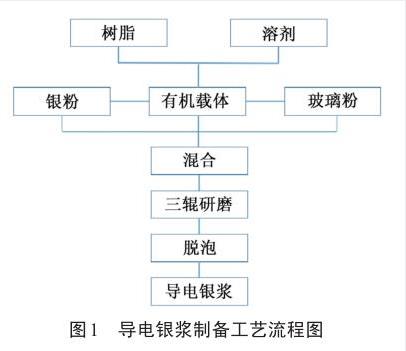
1.2 Sample preparation
The prepared conductive silver paste was printed on a 96% alumina ceramic substrate by screen printing. The screen was made of 250 mesh stainless steel screen, and the electrode was 10 mm × 10 mm square. The oven was dried at 150 °C for 8 to 10 min to ensure that the film layer was dry, and then placed in a box-type sintering furnace, heated to 850 °C for 10 min, and cooled with the furnace to prepare the test sample.
1.3 Performance test
The surface morphology of the film was observed with a Japanese Shimadzu ss-550 scanning electron microscope; the square resistance of the film was tested with a RTS-8 four-point probe of Guangzhou Four-Probe Technology; lead-free solder (Sn96.5Ag3Cu0.5) The tinned lead coated with flux was welded to the sintered silver electrode, and the adhesion of the electrode film layer was measured with a PT-1198GTPL tensile tester.
2 Results and discussion
2.1 The effect of single silver powder morphology on the properties of silver film
In this experiment, four kinds of silver powders with different morphologies and physical properties were selected for research. Table 1 lists the physical properties of the silver powder.
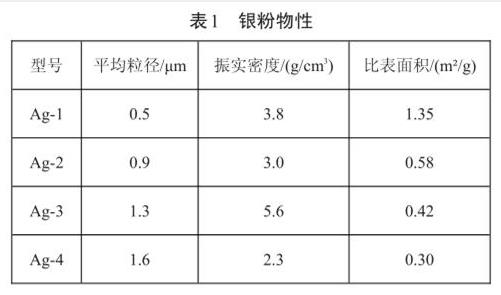
Fig. 2 is the scanning electron microscope photograph of 4 kinds of silver powders selected for use. As can be seen from Figure 2, Ag-1 is a sub-micron irregular microcrystalline silver powder with a wide particle size distribution and a small amount of agglomeration; Ag-2 silver powder is an irregular shape, with a low degree of agglomeration and good dispersibility; Ag- 3 silver powder is a spherical silver powder with relatively uniform particle size, low degree of agglomeration and good dispersibility; Ag-4 silver powder has a wide particle size distribution and irregular morphology, which is spherical silver powder or microcrystalline silver powder. Multiple spheres are connected together.
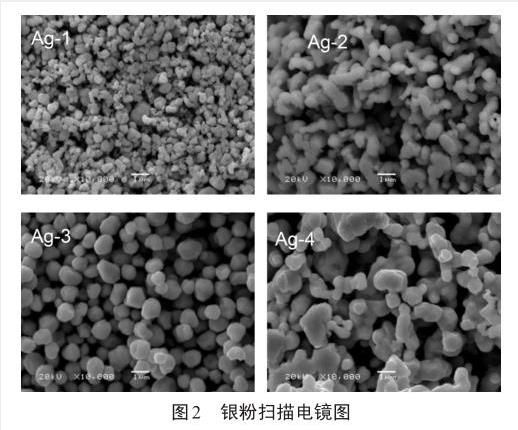
Conductive silver pastes were prepared with four kinds of silver powders, and the properties of silver films were measured after printing and sintering. Figure 3 is the square resistance diagram of the conductive films prepared with different silver powders. It can be seen from Figure 3 that the minimum square resistance of the silver paste prepared with silver powder Ag-3 is 3.2 mΩ/□, and the conductivity is the highest, followed by The silver powders Ag-1 and Ag-2 are 3.9 mΩ/□ and 5.1 mΩ/□ respectively. The Ag-4 silver powder has the worst conductivity, with a square resistance of 7.4 mΩ/□. Combined with the physical properties and morphology analysis of silver powder, Ag-3 has the highest dispersibility and the highest bulk density of 5.6 g/cm 3 . The silver powder has the most contact points during sintering, making it easier for material transfer. Forms dense sintering; the bulk density of silver powder Ag-1 and Ag-2 gradually decreases, and the pores between the powders are more, so the sintering is worse than that of Ag-1 silver powder; silver powder Ag-4 is irregular in shape, and it is not easy to accumulate between silver powders , it is very easy to form holes, resulting in a decrease in the compactness of the film layer, so the electrical conductivity will be reduced.
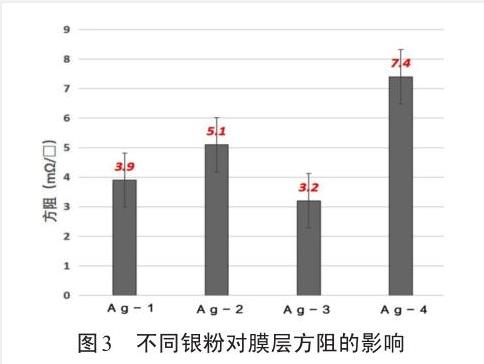
Figure 4 is a scanning electron microscope image of the surface of different silver powder sintered films. It can be seen from Figure 4 that the Ag-1 film is relatively dense, with few pores, and the grain size after sintering is small; the Ag-2 and Ag-4 films have more pores, the powder sintering degree is low, the network structure is loose, and the distribution of voids is not good. uniform, resulting in reduced electrical conductivity; among them, Ag-3 has the best sintering performance, the film layer is dense and uniform, and the silver grain size is large, the grain boundary is small, the silver particles are closely connected and evenly distributed, and the electrical conductivity is better than other 3 kinds of silver powder, which is also consistent with the square resistance test results.
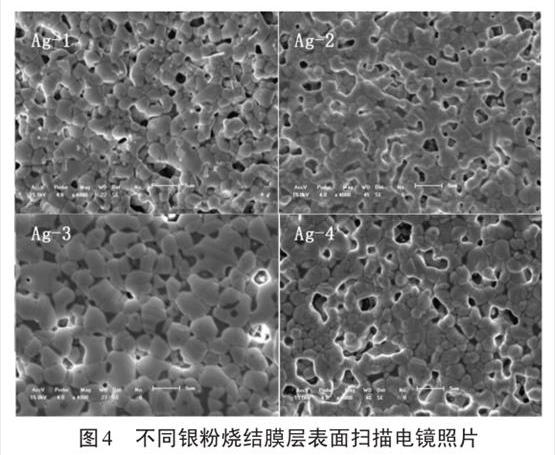
According to the research and analysis of the resistance of the powder particle stacking system by Ruschau G R et al., the resistance of the silver film is composed of three parts: the internal resistance of the silver powder, the contact resistance of the silver powder and the tunneling resistance. Because the resistivity of silver is very low, the resistance of silver itself can be ignored. When the filling amount of silver powder reaches a certain level, the tunneling resistance will be very low, and the effect on the resistance of the film layer will be small. The most important influence on the conductivity of the silver film layer is the contact resistance between the silver powders. The size of the contact resistance is inversely proportional to the size of the contact area between the silver powder particles. The resistance is reduced, thereby reducing the square resistance of the silver film layer. The bulk density of the silver powder is large, and the contact area between the silver powders is large. During the sintering process, the contacted silver powder particles are easily sintered and connected to form a dense conductive network. 1. Ag-2. The bulk density of Ag-4 silver powder is low, the powder contact area is greatly reduced during the sintering process, and the mass transfer effect is weakened. Therefore, after sintering, there are many pores in the film layer, the sintering degree is low, and the electrical conductivity is the worst.
2.2 Influence of mixed silver powder on the properties of silver paste film
The particle size and morphology of the silver powder have a great influence on the conductivity of the silver film. According to the Dinger-Funk powder stacking theory, in order to further improve the compactness and conductivity of the film layer, it is necessary to increase the sintering activity of the powder and improve the powder. Two aspects of filling performance are considered. Ag-3 is used as the main silver powder, and spherical silver powder with an average particle size of 50 nm is selected as an additive to be added to the conductive silver paste, in order to improve the performance of the film layer. The change of the performance of the silver film under the form, the addition ratio is listed in Table 2.
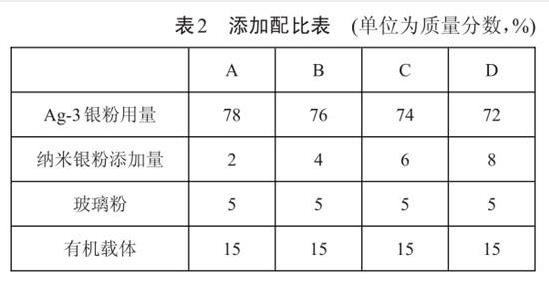
Figure 5 shows the effect of nano-silver powder addition on the square resistance of the film. It can be seen from Figure 5 that with the increase of nano-silver powder dosage, the square resistance gradually decreases from 3.2mΩ/□, and the square resistance is 2.9mΩ when the addition amount is 2%. /□, when the addition of nano-silver powder is 6%, the square resistance is the smallest, reaching 2.1 mΩ/□, and when the addition of nano-silver powder continues to increase to 8%, the square resistance increases to 3.0 mΩ/□.
The analysis shows that with the addition of nano-silver powder, the bulk density of silver powder increases, the porosity decreases, the contact area during sintering increases, and the sintering activity of nano-silver powder is higher, so the formed conductive network is dense and has good conductivity. When the nano-silver powder increases from 0 to 6%, the conductivity gradually increases, the square resistance decreases from 3.2 mΩ/□ to 2.1 mΩ/□, the conductivity is the highest, and the addition amount reaches the maximum value of the Dinger-Funk powder accumulation theory. Small porosity, the film layer at this time is the densest, the square resistance is the smallest, and the best effect is achieved; when the content of nano-silver powder is further increased to 8%, the critical value of this minimum porosity is exceeded, If the size of the silver powder does not match, the porosity increases. At the same time, the particle size of the nano-silver powder is small, the contact area between the silver powder particles is relatively small, the electrons travel within the particles within a short distance, and the number of electron tunneling increases significantly, resulting in contact resistance and The tunneling resistance increases, so continue to increase the nano-silver powder, the square resistance will increase, the holes will increase, the conductivity will become worse, the square resistance will increase to 3.0 mΩ/□, and the film performance will deteriorate.
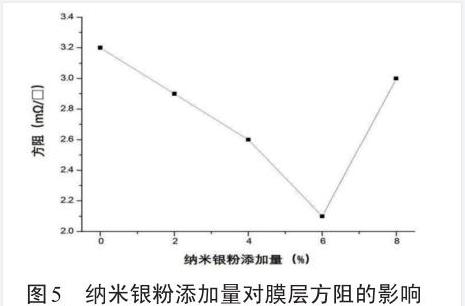
In order to verify the above analysis, the surface of the conductive film layer was analyzed by scanning electron microscope. Figure 6 is a photo of the microscopic morphology of the film layer. Although the original morphology of the silver powder cannot be seen from Figure 6(A), the silver powder particles are melted with each other to form a network structure, but there are a large number of holes in the network, and the density is relatively high. However, with the increase of nano-silver powder addition, it can be seen from the microscopic morphology of the film that the pores gradually decrease and the compactness of the film gradually increases. The apparent morphology in Figure 6(C) Dense and flat, the silver powder particles are closely arranged and fused together. However, as the content of nano-silver powder continues to increase, the square resistance increases, and the microstructure of the film layer becomes looser and more pores, which can be seen from Figure 6(D), which is consistent with the above analysis.
Therefore, by adjusting the appropriate ratio of silver powder, different silver powder particles can be filled with each other during the sintering process of the silver paste, which increases the contact and mass transfer effect, and exerts a synergistic effect, which can make the surface of the silver electrode more compact and smooth, and the performance of the conductive film layer is better.
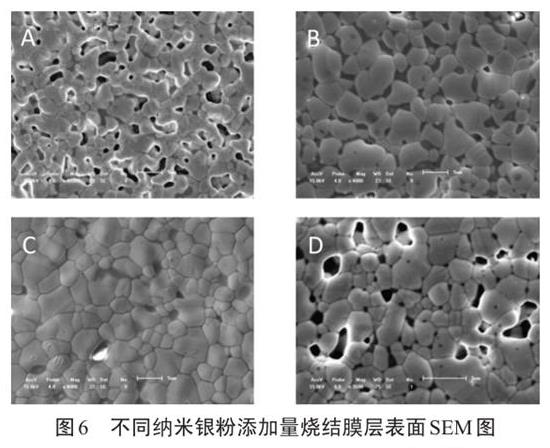
3 Conclusion
(1) When a single silver powder is used, the larger the bulk density, the more contact points of the silver powder during sintering, the easier the material transfer, the formation of dense sintering, and the better conductivity of the sintered film.
(2) The mixing and matching of silver powders with different morphologies helps to reduce the pores of the film layer after sintering, and increases the conductive path between the silver powders, thereby greatly reducing the square resistance of the film layer and improving the comprehensive performance of the silver paste.
(3) When 6% nano-silver powder is added to the spherical silver powder, the square resistance of the sintered film is the smallest, reaching 2.1 mΩ/□, and the film structure is the most dense.